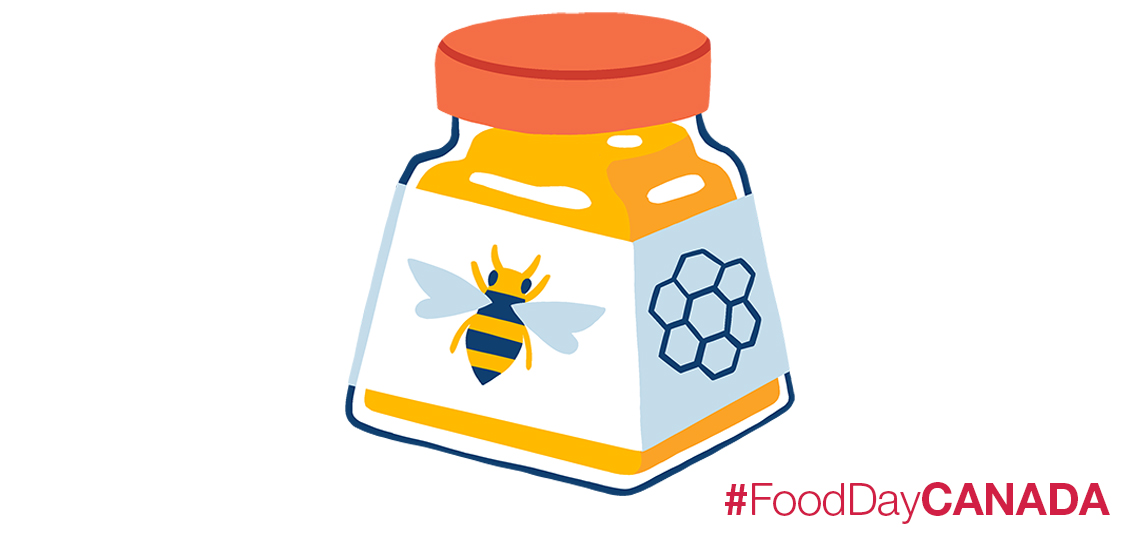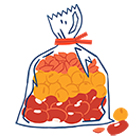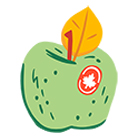Honey: a sweet Canadian ingredient

We’re celebrating Food Day Canada this year by sharing information, recipes and fun facts for the whole family. Many of our alumni and community are balancing working from home and childcare, so we thought we’d share some fun activities to entertain everyone.
Food Day Canada is a great opportunity to enjoy food, make food and learn about food.
Nutritional Highlights of Honey
Like white sugar, honey is a carbohydrate, which provides energy for the body! Different sugar molecules make up the building blocks of carbohydrates. Sugar molecules called fructose and glucose are the building blocks of honey. Other ingredients found in honey include water, pollen, vitamins, and minerals. Remember honey is still mostly sugar, so moderation is important.
Nutrition info for one tablespoon of honey:
- Calories: 63.8
- Carbs: 17.3 grams
- Sugar: 17.2 grams
- Protein: 0.1 gram
- Vitamin C: 0.1 mg
- Calcium: 1.3 mg
- Potassium: 10.9 mg
Fun fact: honey has proven to be an effective way to soothe a cough and sore throat.
Reflection activity: Taste a spoonful of honey. What do you notice? Does it taste like other sugar? What is different or the same? What does the texture feel like on your tongue?
A Honey Recipe to Try!
Orange honey fruit snacks are a tasty and easy snack to make (just three ingredients), which will be enjoyed by the whole family. Plus they act as an immune booster when feeling run down. Check out the recipe for orange honey fruit snacks here.
Fun fact: U of G sells honey harvested from the HBRC’s very own hives. They produce approximately 28 tons of honey each year (an adult male moose weighs about one ton, so that is a lot of honey!).
Reflection activity: Make the recipe. What was the best part of making the recipe? What was the most challenging? Would you change the recipe for next time?
Additonal Food Day Canada approved recipes for honey:
- Wildflower Honey Fudge
- Honey-Tarragon Salad Dressing for Fresh Greens
- Honey Cocoa Balls with Red Lentils
U of G Connection to Honey
The study of honey bees and bee keeping, also known as apiculture, was introduced to the Ontario Agricultural College in 1894 (that’s over 125 years ago). In 1920, an apiculture building was built on campus, making it the first of its kind in North America. The building no longer exists on campus, but honey bee research at U of G is alive and well.
Today, the U of G Honey Bee Research Centre (HBRC) has 13 apiaries, also known as bee yards, with over 300 beehives! Honey bees are very important for food production and plant pollination. It is the HBRC’s goal to help honey bees continue this work through research on honey bee health, breeding and honey bee hive management. They also provide teaching, training, and outreach. Be sure to check out their “how-to” videos to learn more about bee keeping.
U of G also has an apiculture club, where students and honey bee lovers attend bee demonstrations, make beeswax products like lip balm and candles and even bottle and label honey.
Reflection activity: Do a search on the internet to look at photos of bee hives, bee boxes, bee frames and bee keeping equipment. Would you want to be a bee keeper? Why or why not?
Honey Historical Note
Honey and bee keeping have a long history. Archeological evidence and cave paintings show that humans have kept or used bees for almost 9,000 years. It is thought that these people used honey and beeswax for food and medicine, just like today! Fast forward a few thousand years and the honey bee that Canadians know and love today isn’t actually from North America. When Europeans settled in North America they brought the western honey bee with them.
Today in Ontario, honey bees are more valued for their pollination of fruits and vegetables than for their honey production. However, the total sales value of honey in Canada in 2019 was $173.0 million.
Fun fact: The western honey bee can be found on every continent except Antarctica!
Environmental Impact of Honey
Honey is a bee’s source of food, but how do they get it? Honey bees travel from flower to flower collecting a sweet juice called nectar, which is produced by plants. The honey bees use their tongue like a straw to suck up the nectar and store it in their honey stomach. When they return to the hive bees will take turns chewing the nectar, breaking it down into honey. It’s almost like putting a bunch of fruit in a blender to make a smoothie. The nectar is the fruit and the honey is the smoothie.
While honey bees are traveling from plant to plant they conduct an important environmental service called pollination. Pollination is when the male part of a flower, the pollen, is transferred to the female part of a flower, which results in the production of a fruit or vegetable. This service is very important for agricultural crops and wild plants.
It is important to remember however, that the honey bee is not the only bee in Ontario or Canada. There are around 420 native bee species in found in Ontario. Although honey bees do a good job at providing pollination for some systems, it is important to grow a variety of flowers and plants in your yard to ensure all 420+ pollinators have adequate food sources.
Fun fact: The colour and taste of honey is different depending on the nectar source! There are hundreds of different types of honey for example blueberry honey or avocado honey.
Reflection activity: Go outside and see if you can find flowering plants. Can you find any bugs on the flowers? How hard was it to find a flowering plant? What would it be like to be a tiny pollinator looking for a source of food in your neighbourhood?
 |
Learn more:
|
 |
Learn more:
|
 |
Learn more:
|